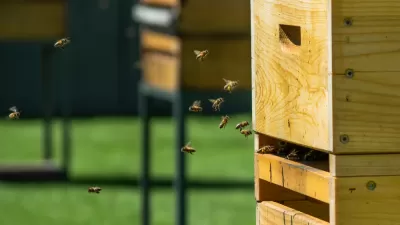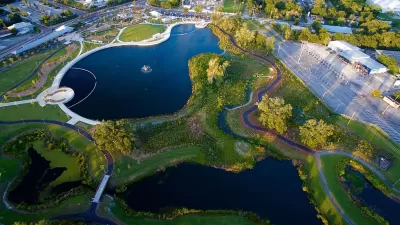Researchers are starting to understand how urban bee populations can support healthy green spaces and reduce the urban heat island effect.

Writing for Wired, Matt Simon emphasizes the importance of bees in urban ecosystems. “Bees are critical actors in a burgeoning scientific field known as rurbanization, a way to improve food security and beautify urban landscapes.”
A group of researchers in St. Louis is working to identify the bee species that pollinate local plants and how to attract and protect the bees. “For example, bees don’t like big, open spaces. They appreciate vegetal cover—places to hide from predators like dragonflies that are waiting to pick them off.” Bees also thrive when patches of plain soil are present, something that might seem counterintuitive or aesthetically displeasing to gardeners.
Supporting urban bee populations isn’t just about aesthetics or having flowers or fresh herbs, Simon points out. “A community garden ‘sweats,’ as plants release water vapor, cooling the neighborhood—and if you’re in the garden itself, you can enjoy its shade.” Urban green spaces can help mitigate the urban heat island effect and reduce temperatures in cities. “The researchers hope their surveillance project will spur research in other cities so scientists can figure out how to nurture the relationship between pollinators and people.”
FULL STORY: Cities Need More Native Bees—Lots and Lots of Them

Study: Maui’s Plan to Convert Vacation Rentals to Long-Term Housing Could Cause Nearly $1 Billion Economic Loss
The plan would reduce visitor accommodation by 25,% resulting in 1,900 jobs lost.

North Texas Transit Leaders Tout Benefits of TOD for Growing Region
At a summit focused on transit-oriented development, policymakers discussed how North Texas’ expanded light rail system can serve as a tool for economic growth.

Why Should We Subsidize Public Transportation?
Many public transit agencies face financial stress due to rising costs, declining fare revenue, and declining subsidies. Transit advocates must provide a strong business case for increasing public transit funding.

How to Make US Trains Faster
Changes to boarding platforms and a switch to electric trains could improve U.S. passenger rail service without the added cost of high-speed rail.

Columbia’s Revitalized ‘Loop’ Is a Hub for Local Entrepreneurs
A focus on small businesses is helping a commercial corridor in Columbia, Missouri thrive.

Invasive Insect Threatens Minnesota’s Ash Forests
The Emerald Ash Borer is a rapidly spreading invasive pest threatening Minnesota’s ash trees, and homeowners are encouraged to plant diverse replacement species, avoid moving ash firewood, and monitor for signs of infestation.
Urban Design for Planners 1: Software Tools
This six-course series explores essential urban design concepts using open source software and equips planners with the tools they need to participate fully in the urban design process.
Planning for Universal Design
Learn the tools for implementing Universal Design in planning regulations.
Ascent Environmental
Borough of Carlisle
Institute for Housing and Urban Development Studies (IHS)
City of Grandview
Harvard GSD Executive Education
Toledo-Lucas County Plan Commissions
Salt Lake City
NYU Wagner Graduate School of Public Service




























